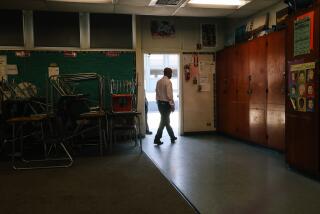Don’t Forget the Bricks and Mortar : Steps for New Classrooms Trail Other Education Gains
- Share via
California seems to be making a renewed commitment to financing public education as the state lottery pumps millions into school programs, the Legislature considers dramatic pay increases for top teachers, and educators even propose financial incentives for students to stay in school. Hardly anyone, however, is talking about financing to provide for primary and secondary school facilities in which to carry out the work of education.
The problem is critical in Southern California--from inner-city Los Angeles, where antiquated schools swamped by high birthrates and immigration operate year round on double sessions, to newly developing communities in the Inland Empire, where a housing boom is overwhelming small, previously stable districts.
Before 1978, school-construction financing was primarily a local affair, with districts selling general-obligation bonds to be paid off by all property taxpayers in the jurisdiction. Proposition 13 limits on new tax obligations put an end to that approach and made local districts almost totally reliant on the state for the funding of permanent facilities. Districts experiencing rapid growth also began to rely on contributions from housing developers for temporary facilities until state funds could be obtained and schools built.
The result is a process fraught with both ineffectiveness and inequity. A resolution of the situation will require a comprehensive, state-level response, consisting of the following elements:
Sufficient, reliable state funding. An estimated 26,000 new classrooms--plus associated offices, libraries, gyms and auditoriums--will be required statewide in the next five years alone, at a cost of $6 billion. State funding for new construction is currently at less than 20% of that level.
Revised eligibility criteria for such funding. Many districts do not qualify for even the limited state funding now available, either because their existing schools don’t conform to current state standards or because their teacher contracts limit class size below state minimums.
Limits on “exactions” from housing developers. Districts experiencing substantial new housing development typically demand payment of fees or donation of facilities by builders, even if the districts will eventually receive state aid. These costs, which now run as high as $6,000 per housing unit, are largely passed on to new home buyers, who thereby wind up footing the entire bill for what has historically been considered a community resource.
For prospective first-time buyers, this may tip the scales of affordability against them entirely. Those who do buy will pay many thousands more over the life of their mortgages--while seeing earlier residents, who escaped such fees, utilizing the schools financed by the newcomers. This situation is bound to be exacerbated by a recent California Supreme Court ruling that would allow developers’ fees to be used for permanent facilities.
Furthermore, to whatever extent such fees are imposed, they provide no relief for districts such as Los Angeles that have comparatively little new residential growth to tax.
New local financing options. School districts are able to utilize locally imposed special taxes, which typically are approved only for future housing development. Thus the burden falls on the newcomers to the community. Districts’ authority to utilize general-obligation bond financing needs to be restored.
At the same time, local governments need authority to create “benefit assessment districts,” the costs of which must be spread over the entire community.
Districts that take the initiative to raise funds locally to provide schools more quickly should be reimbursed by the state at the point at which they would normally qualify for state aid. If such reimbursements were assured, developers would be willing to construct permanent schools as a preferable alternative to paying fees or providing temporary school facilities.
A requirement for long-range planning by school districts. Many have been needlessly caught without adequate facilities to accommodate burgeoning needs. Often these could have been anticipated by studying development trends and demographic changes.
A package of bills proposing precisely such a combination of remedies passed both houses of the Legislature earlier this year, with solid support from the educational community, the building industry and local governments, only to be vetoed by Gov. George Deukmejian. His veto message indicated considerable skepticism regarding the extent of the problem and a reluctance to allocate substantial state resources. State Sen. Leroy F. Greene (D-Carmichael), considered the father of the current state funding program, was quoted as replying: “While the governor is fooling around, trying to find out precisely what the numbers are, the problem is getting worse and he’s not solving any of it.”
With the start of the new legislative session in January, and the advent of an election year as well, it can be expected that school-facilities financing will be near the head of the agenda. Whether the problem is addressed depends on whether the key public decision-makers can be educated as to the full magnitude of the problem. One fact may be sufficient: When schools open next fall, there will be 100,000 more students requiring additional facilities in which to obtain an education.
More to Read
Sign up for Essential California
The most important California stories and recommendations in your inbox every morning.
You may occasionally receive promotional content from the Los Angeles Times.










